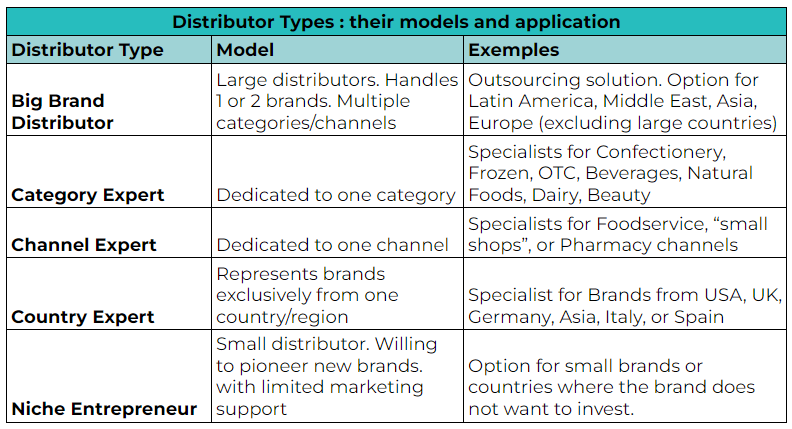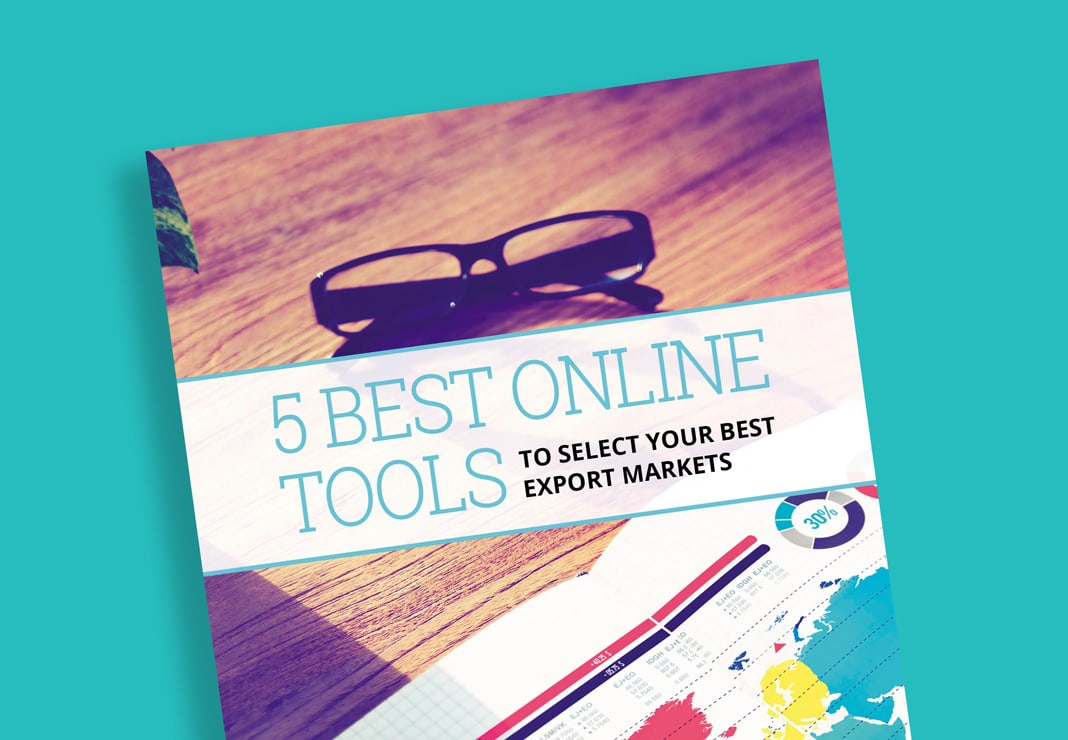A rigorous selection of a distributor to enter a new export market is an chief factor for international success. Well-off companies strive to identify distributors with the right fit in terms of business strategy and investment to create solid foundations that underpin their business’ international development. It is essential to pay particular attention to this selection because it represents many consequences for your business. Indeed, the challenges are multiple as the distributor must be able to penetrate the market but also sustain and increase market share in the long term. The stakes of a good selection of your distributor are economic but also of brand image.
The way your future distributor preforms can impact your reputation with your end customers but also with your partners in the countries concerned. To ensure the best possible choice of an international distributor, we share with you the key steps of the effective selection process.
What is an international distributor?
International distributor is a person or company that buys products from a manufacturer and sells them for a profit to other businesses, stores, or customers, often by transporting the goods or by selling them online. They are often appointed as distributors in a country, several countries and very seldomly a region. The appointment becomes an agreement between a manufacturer and a distributor that outlines terms of the relationship, such as manufacturing, distribution, ownership, duration, price and intellectual rights, and other matters.
Defining the type of distribution model
The complexity of implementing an international distribution model can vary depending on the type of distributor chosen. Sometimes a company or product manufacturer will have overlapping distribution channels. Distributors are able to help grow a product or company, gaining markets through their established networks that you may not have been able to reach otherwise. They may be individual agents or a sales company. Distributors or retailers often communicate to product manufacturers exactly what the consumer wants, making it very important for the company to best meet the needs of the market. In addition, some distributors serve specialized market segments or types of products, such as restaurant wholesalers and car dealership wholesalers who work with certain brands. Knowing the distribution options available is critical to determining your ideal distributor profile, which will be discussed in more detail below. Here are the 4 main types of distributors involved in the distribution process to international:
Distributors
The role of distributors is to resell items and ensure the after-sales activities. They often handle import, marketing and contact with resellers and manufacturers. The distributors are dealing with import requirements and compliance or sometimes subcontract these activities to specialized parties. They also deal with delivery or order problems and help the companies they represent to grow by using its network that the company alone would not have access to. They similarly sell on behalf of the manufacturer and study market trends and consumer activity to better plan future orders, shipments, and sales. The best distributors work hand in hand and rely heavily on market research and feedback from retailers who are on the front lines with end customers. Distributors may sell to wholesalers, retailers, and agents.
There are exclusive or sole and non-exclusive distributors. The exclusive distributor works only for your company and does not represent any other competing brands. They fully dedicate themselves to your interests in the designated market. The non-exclusive distributor represents many brands and allocates resources to each brand as specified in their mutual contractual agreements. For example, a company like Scandinavian Cosmetics Group, distributes more than 30 brands on the Scandinavian market through department stores, E-tailers, fashion houses, concept stores and pharmacies throughout the Scandinavian market.
The main advantages of this type of distribution are rapid access to the market and good knowledge and connection to the market and the handling of activities by the distributor. The disadvantage is the high dependence of the company towards the distributor and their network, thus the importance of the good selection of the partner as a distributor. In case of a non-exclusive distributor, the companies should understand how important their brand or product is for the partner and how much time and resources they are will allocate to its interests on the export market they represent for the company.
Wholesalers
Wholesalers are intermediaries between manufacturers, distributors and retailers. In effect, the wholesaler buys items in bulk to negotiate the lowest price to resell them later. Wholesalers very rarely interact with consumers. Their activities are mainly negotiation with manufacturers, storage, and delivery to retailers for the consumer market.
The wholesaler has several advantages which are:
a) many retailers served and sometimes full geographic coverage of a country,
b) ability to sell a large volume which provides needed cash to the manufacturer,
c) wholesalers can ensure faster delivery to buyers because they are closer to them than producers and take care of the transportation costs to the customer.
However, dealing directly with a wholesaler is not the best way to reach a new export market. The main disadvantage of the wholesaler is that they are not involved in marketing activities and are not in touch with the end-users and aren’t able to be as responsive to the changing needs of the end consumer.
Retailers
Retailers resell items to end consumers through physical stores or online through e-commerce sites. Retailers purchase their inventory from distributors such as wholesalers for resale purposes. They are the ones who are in direct contact with the end consumers and develop their offers to be more competitive.
As your customer base grows it becomes difficult to deal with them directly unless you build up your own local sales force or open a branch. Using retail distribution allows you to penetrate a market efficiently while conserving your own resources. Indeed, it is the retailers who will be in direct contact with the final customers. In addition, retailers take care of stocking their merchandise and therefore reduce your own storage costs.
Nonetheless, there is a disadvantage which is the lack of control over the marketing done by the retailer. Indeed, if a retailer fails to sell a product, it is possible that they will choose to discontinue your product or lower the price which would impact the image of the product on the foreign market.
Agents
Agents have a slightly different role because they often represent the manufacturer. On behalf of the brand, agents will manage the marketing and customer relationship aspects on behalf of the manufacturer. Often paid on a commission basis, agents resell to wholesalers and retailers and are often required to meet sales targets in their market. Using an agent is a complex solution but can be effective.
Operating with an agent can be beneficial if the manufacturer wants to retain more control over the marketing channel and customer relationships, such as key accounts. It allows him to keep the closer link because it is the manufacturer who keeps the contractual relationship and the after-sales service. It is also possible that an agent is less expensive than a distributor because an agent’s commission may be less than the discount that a distributor may require. A third advantage is that the agent may be more motivated to perform because he or she is paid on commission. And finally, legal ownership of any products concerned does not pass to the agent, and legally, each customer’s contract is with the producer not the agent. Therefore, the manufacturer assumes legal and commercial risk whereas an agent does not. As for the disadvantages, unlike with a distributor, a manufacturer who uses an agent takes on much more risk and responsibility. For example, the producer takes responsibility for the condition of the products upon receipt. Subsequently, it is up to the producer to insure and compensate his customer in case of theft or damage.
Recognize distributor models
After defining the choice and degree of involvement of your ideal distributor, it is necessary to identify which type of distributor would suit you best according to your activity. We will compare 5 types of distributors and their business models: brand experts, industry experts, channel experts, country experts and niche entrepreneurs. Some are more generalist while others specialize in sectors. It’s up to companies to choose which distribution model is best suited to meet their strategic goals.

- Brand Experts (Big brand distributors) offer a cheaper alternative to large brands than operating their own international subsidiary. In general, these distributors manage several segments and offer mass distribution. A potential disadvantage is that big brands must fight for the attention and focus of one sales team.
- Category or industry expert distributors have excellent market knowledge specifically for the industry and offer significant logistical and sales efficiencies. This type of distributor is interesting for technical products in their characteristics or their transport which is not always easy to sell as for example the health or food sector.
- Channel Experts are distributors who focus their business on a specific distribution channel. For example, many specialize in supermarkets, but additional growth comes from other smaller, underserved channels or emerging channels such as drugstores or small stores, or e-commerce. These can be a barrier to entry for all but the largest brands.
- Country or area experts are distributors who have created companies that have become sources of a country’s brand. That is, these distributors provide specific communities with national brands in other countries (Italian, French, Korean, South African etc). This approach works well for niche segments.
- Niche Entrepreneur. When you want to launch a brand in a country without existing sales or brand recognition, market penetration is difficult. While many brands favor specialized and prestigious distributors, the reality is that a smaller distributor may be your best option for getting started. Niche entrepreneurs are voracious and flexible, willing to work without significant resources provided by the brand. Still, you should be careful about what you expect from a niche entrepreneur and be cautious about their financial situation.
Ideal distributor profile
Now that you know the distribution modes and types of distributors, it is time to move on to the selection of the distributor. To do this, you must first define the ideal distributor profile for your company and your objectives. It is a matter of deciding on a certain number of significant criteria that will allow you to select the distributor that corresponds to your needs and to pre-select your candidates before the first contact. These criteria can be the number of years in this activity, specialization in your sector, the number of customers in his portfolio, who are these customers etc. These criteria allow you to evaluate the expertise of the candidates and if they correspond to your needs. For example, a company that sells very specific products such as construction equipment cannot entrust the sales of its products to a specialist in wine or cosmetics. It is also important to keep an eye on the competition or industry by screening the distributors selected by your competitors and benchmarking your own choice.
Competitive study of distributors and contacts
Once the determination of the ideal distributor profile you must launch the process to identify players in the target countries. First, create a large group of potential candidates. Include candidates who have emailed you or visited you at a trade show. Highlight companies that specialize in your industry.
As a next step, you can determine candidates’ preliminary interest level by sending an email and then have a call around 48 hours later. In your email, you should present your company and product proposition to the 5 to 10 most promising candidates. You should have distributors who express interest fill out a brief company profile and basic information such as sales, coverage, key personnel, etc. This will allow you to make an initial assessment of whether the candidate matches, or at least comes close to, what you have defined in your ideal profile. Set up a meeting with distributors who express interest and match your predefined criteria in their office. This step helps you meet with the distributor’s team and managers and visit their venue. It is advisable to schedule the meeting 4-6 weeks in advance and have a specific agenda at least 3 weeks in advance. Preparing a distributor evaluation grid allows you to evaluate and compare them to your ideal profile. Together with your different prospects, it is advisable to visit points of sales retailers to add sources of information, to observe how they operate and if they correspond to your expectations. During your visit, try to answer these questions: Do its current brands maintain a strong presence in the market? Or are its products or brands hard to find on the shelf? Do they serve the same customers I target?
And before we conclude, a refresher on other key steps for companies that wish to export efficaciously. First, companies must define their international objectives and then proceed with the selection of markets. The importance of this phase should not be overlooked. Indeed, an excellent distributor cannot fill the lack of demand in a country. To continue, efficient international distributor selection starts with selecting the right entry mode for the selected country or countries. Many SMEs tend to seize the first opportunity, although it is very critical to reflect on this matter, as the entry mode is another key factor for international success. There is no single “best“ way for international entry and solutions may vary from one country to another and/or from one industry to another. Thus, the choice of entry mode depends on the country and the target market, but also on the company’s strategy, its skills, and the financial and human resources it can mobilize for its export activity. This analysis does not necessarily lead to the choice of the best mode of entry, but it does allow the elimination of different modes of entry that will not be accessible to the company given its capabilities. An answer for the company may be to choose to outsource to a greater or lesser extent the skills that it lacks, depending on the entry mode.
Key takeaways
In summary, the selection of a distributor to access an international market is a rigorous process that requires careful consideration. It is essential to have a well-structured strategy in order to effectively define your needs and make the most appropriate decision. First of all, the study and selection of your target markets allow you to choose a mode of entry adapted to the country which defines if you call upon a distributor or if you enter directly by establishing an office in the country. All these strategic steps allow you to specify your needs and to define the ideal profile of your future distributor according to its mode of operation and the level of specificity you need. Once the evaluation characteristics have been determined, you must proceed with the selection of the distributor through physical and virtual interviews with the candidates but also with their customers or the main retailers of the target country or countries. The evaluation can be done through an evaluation grid with points to be attributed according to the information collected on each candidate.
Although all these steps seem tedious, it is nevertheless necessary for a company to be thorough in its selection of international distributors as it is not one employee who is hired but an entire team that will represent your company internationally.
How Prime Target can help you in your internationalization ?
Prime Target offers to assist companies in the selection of markets to target. Our solution is delivered in the form of a top 5 to 20 countries with fully customized recommendations. Click here to find out more




